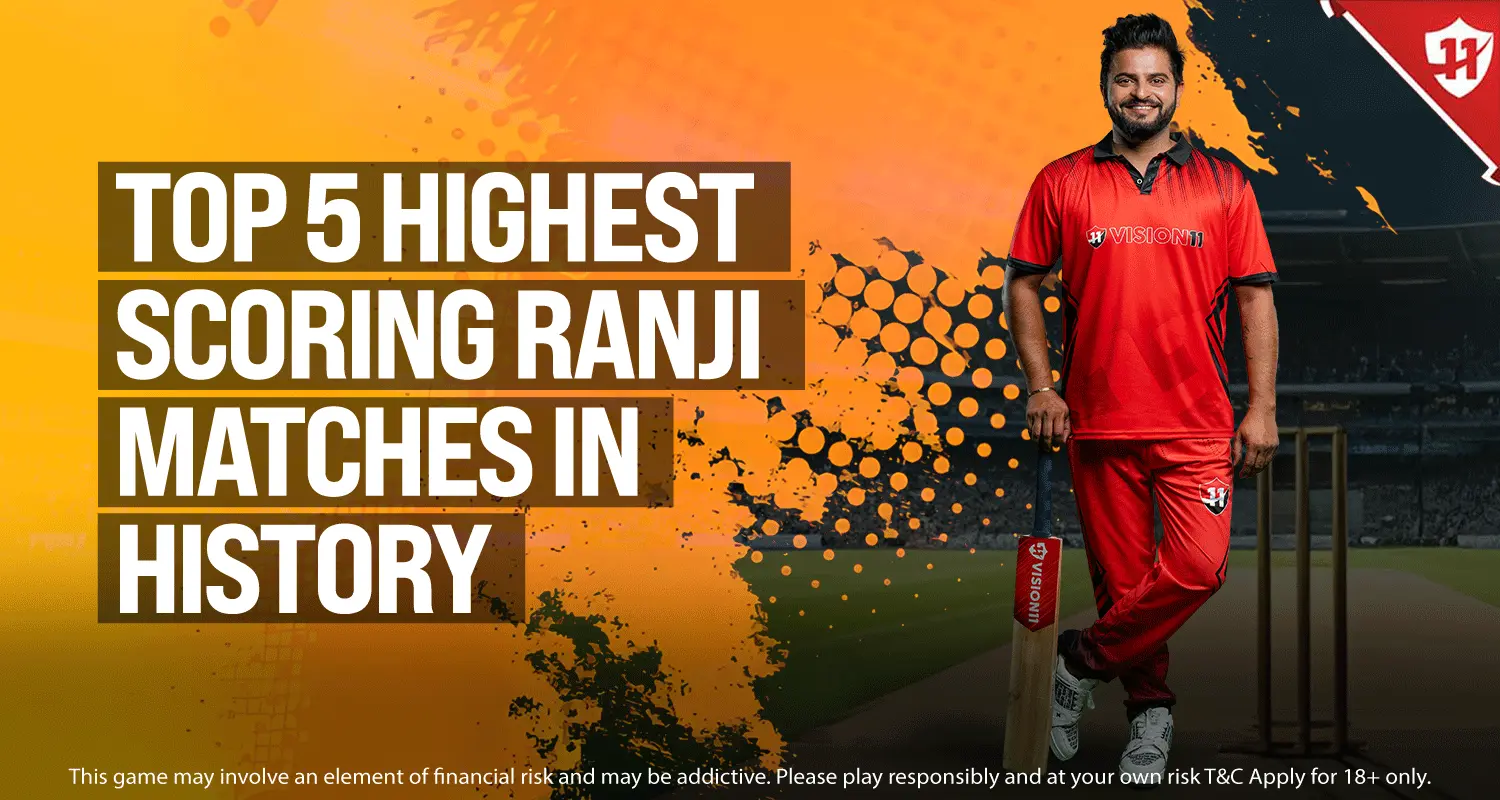The Ranji Trophy has been India’s premier domestic cricket competition for over nine decades. Over the years, it has produced world-class players, unforgettable rivalries, and matches of every imaginable shape and size. But some matches stand apart for a special reason: their massive run totals. These contests didn’t just feature good batting, they redefined scoring standards, with innings that stretched across days and tested the very limits of endurance, patience, and concentration.
In this article, we revisit the five highest innings totals in Ranji Trophy history—games where the batters simply refused to get out and bowlers could do little but watch the scoreboard tick endlessly.
1. Hyderabad – 944/6 declared vs Andhra (1993–94)
Venue: Gymkhana Ground, Secunderabad
Season: 1993–94
This match holds a permanent place in Indian domestic history. Hyderabad racked up a staggering 944 runs for just six wickets—a Ranji Trophy record that still stands tall.
- Sridhar’s epic 366 was more than just runs—it’s still remembered as one of the finest efforts in domestic cricket.
- Vivek Jaisimha scored 211, and Noel David remained unbeaten on 207*.
- The partnership between Sridhar and Jaisimha alone was worth over 300 runs.
- The innings lasted nearly three days, with Hyderabad declaring only after completely flattening Andhra’s bowling unit.
Despite all the runs, the match ended in a draw—understandably so, since time simply ran out.
2. Tamil Nadu – 912/6 declared vs Goa (1988–89)
Venue: Bhausaheb Bandodkar Ground, Panaji, Goa
Season: 1988–89
Tamil Nadu’s innings of 912/6 declared remains the second-highest team score in the competition’s history.
- Arjan Kripal Singh scored a double century.
- WV Raman, who would later go on to coach the Indian women’s team, also contributed with a big hundred.
- Tamil Nadu batted for two full days before declaring.
Goa’s bowlers had no answer as Tamil Nadu’s top and middle-order piled on the runs, capitalizing on the flat track and under the sweltering Goan sun that offered no movement or bounce.
3. Holkar – 912/8 declared vs Mysore (1945–46)
Venue: Indore
Season: 1945–46
The Holkar team, a powerhouse in Indian domestic cricket at the time, equaled Tamil Nadu’s score with 912 for 8 declared against Mysore in a semifinal.
- Holkar’s innings featured six individual centuries, a record for a single first-class innings.
- Players like Kamal Bhandarkar, C.K. Nayudu, B.B. Nimbalkar, and Rameshwar Pratap Singh all crossed the 100-run mark.
- The team showcased the kind of batting depth rarely seen even at the international level.
This match laid the foundation for Holkar’s dominance in the pre-independence era and demonstrated what a team of seasoned and confident batters could achieve.
4. Jharkhand – 880 all out vs Nagaland (2021–22)
Venue: Eden Gardens, Kolkata
Season: 2021–22 (Preliminary Quarterfinal)
One of the more recent entries on the list, Jharkhand’s 880 all out came against Nagaland during the knockout stages of the pandemic-affected 2021–22 Ranji season.
- Kumar Kushagra, then just 17, scored an impressive 266.
- Shahbaz Nadeem, primarily known for his bowling, contributed a stunning 177.
- The innings also featured a century from Virat Singh.
Jharkhand’s performance made headlines not just for the total but for the youthful nature of the team, proving that the new generation of domestic cricketers could match and even exceed historic standards.
5. Mumbai – 855/6 declared vs Hyderabad (1990–91)
Venue: Wankhede Stadium, Mumbai
Season: 1990–91 (Semifinal)
Mumbai, formerly known as Bombay, has a long history of batting dominance. Their 855/6 declared against Hyderabad is still one of their most iconic innings.
- The standout of the match was Sanjay Manjrekar, who scored a career-best 377, one of the highest individual scores in Ranji history.
- The innings also included 48 penalty runs, due to Hyderabad’s slow over rate—a rare occurrence.
This innings cemented Mumbai’s reputation for producing top-order batsmen with exceptional discipline and technical skill.
What Do These Matches Prove?
These five matches are more than just statistical landmarks. They’re a testament to the depth of Indian domestic talent, the importance of patience in long-format cricket, and the kind of magic that can unfold over four-day matches.
Common factors in these games include:
- The pitches are usually flat and dry, not much there for the bowlers.
- Strong batting line-ups with several experienced first-class players.
- Extended partnerships that wore down opposition attacks.
- Drawn matches due to the sheer time consumed in building those gigantic scores.
Final Thoughts
While today’s cricket world increasingly gravitates toward fast-paced formats like T20s, matches like these remind us of the beauty of endurance, patience, and precision. These high-scoring Ranji games are not just record-breaking spectacles—they are case studies in how deep batting lineups, favorable pitch conditions, and mental stamina can create historic moments.
They also highlight that Indian domestic cricket isn’t just a stepping stone to international cricket—it’s a stage where legendary performances are born.
FAQ’s ?
Hyderabad’s 944/6 declared against Andhra in 1993–94 is the highest ever.
Back in 1948, Bhausaheb Nimbalkar made history with a 443 for Maharashtra—a record that’s yet to be broken in the Ranji Trophy.
They are less common now due to improved bowling attacks and more balanced pitches, but they still happen occasionally.
Because scoring over 800 or 900 runs takes multiple days, there's often not enough time left in the match to bowl the other team out twice.
Yes. Holkar and Tamil Nadu both have innings of over 900 runs to their name.
Share Post on:
